By HONG LEI
By HONG LEI
OFFICIAL exchanges between China and the U.S. in 1979 were few. Today, however, they hold close, high-level exchanges and operate smooth dialogue mechanisms.

The two nations have established over 100 inter-governmental dialogue mechanisms, including the strategic dialogue, people-to-people exchange mechanism, and the China-U.S. Joint Commission on Commerce and Trade, covering politics, economics, security, culture, science and technology, and other fields. Moreover, there are 47 friendly pairings between Chinese provinces and U.S. states as well as 215 twinned cities.
Ever Closer Bilateral Ties
Bilateral trade volume between China and the U.S. in 1979 was just US $2.45 billion, and direct investment between them was zero. In 2016, bilateral goods imports and exports amounted to US $578.59 billion. China is the U.S.’s third largest export market and largest source of imports, and its largest trading partner. Conversely, the U.S. has become China’s largest trading partner, largest export market, and fourth largest source of imports.
In 2016, bilateral two-way investment amounted to US $170 billion. Chinese companies’ direct investments in the U.S. hit US $45.6 billion, almost double that of 2015.
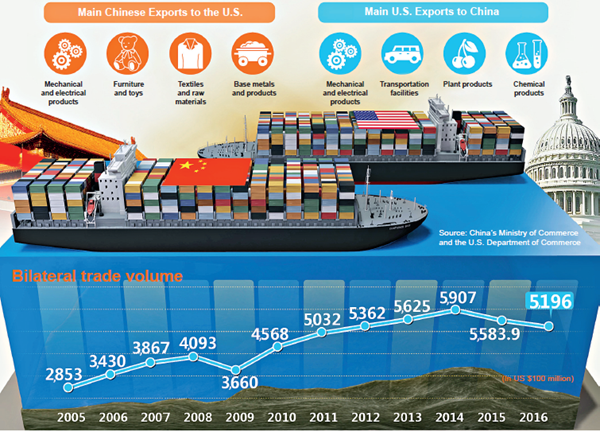
The Boeing Company sold one third of its civil airplanes to China, and 22 percent of the U.S.’s cotton and 56 percent of its soybeans were sold to China. Governor Terry Branstad of Iowa, the prospective U.S. ambassador to China, told me that China buys more soybeans from Iowa alone than any other country combined. China is also a huge market for General Motors, Ford, and Chrysler, headquartered in Michigan, whose car sales account for 13 percent of the Chinese market.
In 1979, visits between Chinese and American people to one another’s country were below 10,000. In 2016, five million people from both countries crossed the Pacific Ocean, among them 2.6 million Chinese travelers to the U.S. In 1979, there were scarcely any students from the Chinese mainland at American universities. Today, 300,000 Chinese students are studying in U.S. universities, accounting for one third of America’s overseas students, and constituting the largest group of international students.
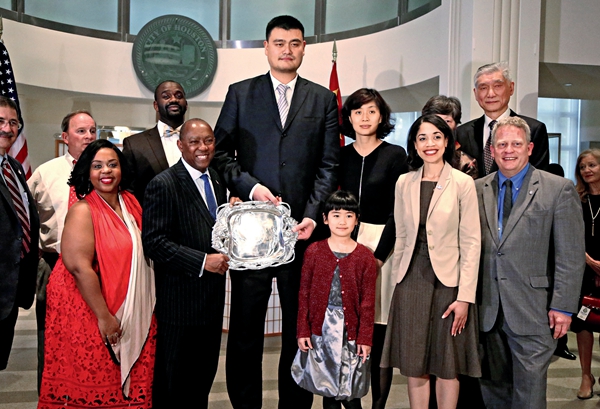
Over the past few years the frequent and close interactions between the leaders of the two powers on bilateral and multilateral occasions have built up strategic mutual trust. Sino-U.S. economic and trade relations are highly complementary and interdependent. Exchanges between the two countries in such fields as education and tourism, among others, have enhanced mutual understanding and deepened cultural exchanges and cooperation.
The two countries have also maintained effective coordination and played important roles in major international and regional affairs. It is thus clear that the two nations’ common interests far outweigh their differences. Cooperation between us is conducive to global stability and prosperity, and also fulfills the expectations of the two peoples and the international community as a whole.
Four Unchanged Elements
The new U.S. administration assumed office earlier this year, and the direction of the future development of Sino-U.S. ties is under close scrutiny. I believe that four facets will remain unchanged irrespective of how the domestic and international landscapes play out.
First, the vast common interests of China and the U.S. have not changed. From trade to investment, educational exchanges to people-to-people exchanges, macroeconomic policy coordination to global economic governance, and from disease control to disaster prevention, the two countries’ common interests in bilateral and multilateral fields are expanding. We have forged a community of shared interests.
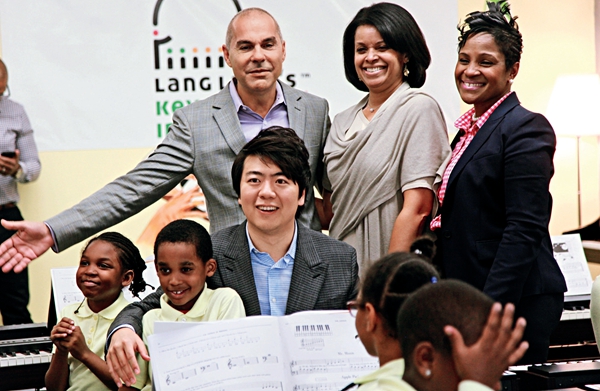
Second, the opportunities mutually generated by the development of the two countries have not changed. China’s economy is expected to maintain medium-to-high growth. Its GDP grows by US $800 billion annually, equivalent to the economy of Indonesia.
According to estimates, China’s total imports in the next five years will reach US $8 trillion and its foreign investment US $750 billion; meanwhile its outbound visits will total 700 million. These will bring more economic opportunities to all countries of the world including the U.S.
The U.S. is also proactively upgrading its manufacturing sector and carrying out technological innovations, infrastructure construction, and other development strategies. Sound Sino-U.S. economic growth has created a broad scope of cooperation between the two countries.
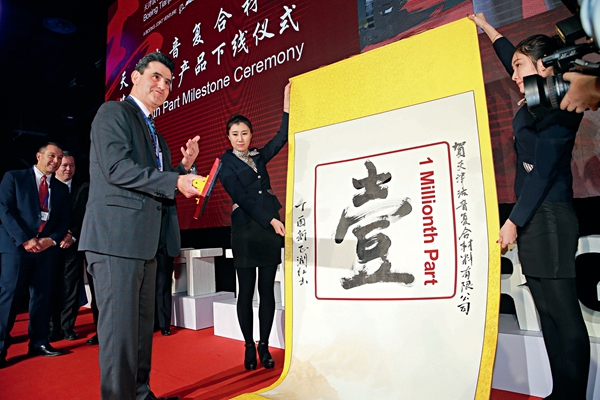
Third, the expectations of the two countries and their peoples as regards steady development of bilateral relations have not changed.
Michigan Governor Rick Snyder has visited China annually for six consecutive years in efforts to facilitate cooperation between Michigan and China. His state has established a friendly state-province relationship with Guangdong, which boasts the largest economy of all Chinese provinces. Governor Snyder remarked that cooperation with China should be a matter of common sense for the people of Michigan.
Governor Branstad of Iowa first met Chinese President Xi Jinping in 1985. Xi was at that time Party secretary of Zhengding County, Hebei Province, and in Iowa on an agricultural observation trip. Having met once more in Iowa in 2011, the two have become close friends. Governor Branstad has visited China many times since then. He observed that Iowa and China have been engaged in mutually beneficial cooperation based on mutual respect and trust, and forged a solid partnership. He believes Iowa is ready for more extensive and practical cooperation with China.
Fourth, the international community’s expectation that China and the U.S. can jointly safeguard world peace, development, and stability has not changed.
The two powers account for one third of the world’s economy, one quarter of the world’s population, and one fifth of the world’s total trade volume. Consequently the world has great hopes that they will play a constructive role in promoting economic growth and confronting global problems, regional conflicts, and hot-spot issues. The healthy and stable development of bilateral relations between China and the U.S. is of great significance to world peace, security, stability and prosperity.
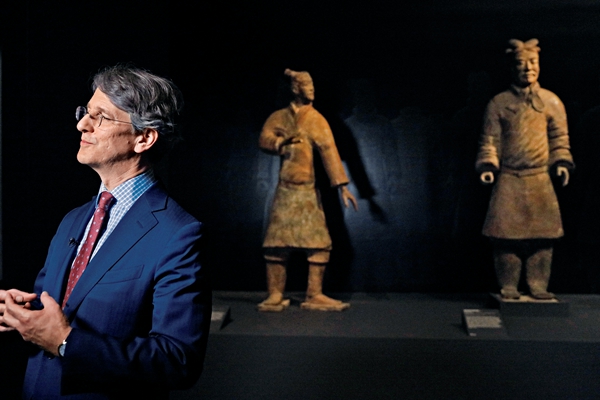
It is fair to say that these unchanged elements bolster the certainty of Sino-U.S. relations, that is to say, that China and the U.S. choose friendship and cooperation as their future development direction.
President Xi Jinping and President Donald Trump had an important and successful telephone conversation last February reaffirming the importance to the two countries and the world of their bilateral relations. President Trump made clear that the U.S. government agrees to honor the One China policy, a commitment which President Xi Jinping commends. The two heads of state agreed to maintain close ties and strengthen exchanges and cooperation.
The important consensus that the two top leaders reached has maintained the political foundation of Sino-U.S. relations, cleared political obstacles to the development of bilateral relations, alleviated any concerns and doubts of the international community with regard to Sino-U.S. relations, and provided the necessary conditions for regional and global cooperation in all areas between the two countries.
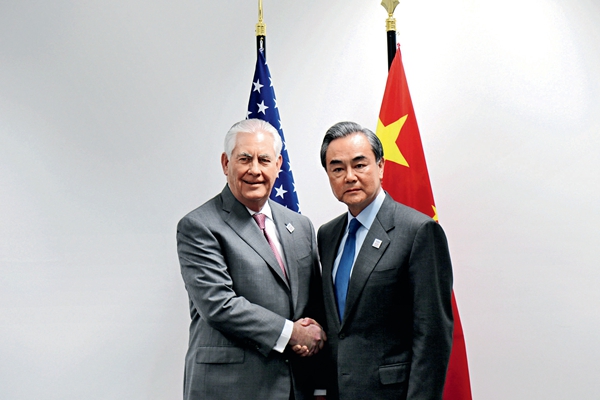
Last February was also when China’s Foreign Minister Wang Yi first met with Secretary of State Rex Tillerson on the sidelines of the 53rd Munich Security Conference. Wang said that China and the U.S. should strengthen communication, enhance mutual trust, manage differences, and deepen cooperation according to the principles of non-conflict, non-confrontation, mutual respect, and win-win cooperation. They can then ensure greater development of bilateral relations under the Trump administration, expanded benefits for their peoples, and more contributions to world peace and prosperity. Tillerson declared that friendship alone would define the relations between China and the U.S., and that the U.S. looks forward to conducting high-level exchanges with China, strengthening cooperation, and lifting bilateral relations to a new high.
Looking Forward to Greater Progress
The achievements we have made are indeed inspiring. As the world’s most important bilateral relationship, China-U.S. relations bear on the future of the world and of humankind. The choices we make today will have a profound impact on the wellbeing of the two peoples and the future of the world.
The most pressing task is to propel bilateral relations beyond the run-in period without delay, and ensure greater development under the Trump administration. I would like to offer some thoughts on how to accomplish this task.
First and foremost, we should view each other’s strategic intentions appropriately, respect each other’s core interests and major concerns, and handle and manage disputes in a constructive way.
China is a peace-loving nation, and has no intention of challenging the U.S. Neither is China’s development aimed at overpowering that of others. Although China’s socialist modernization has made remarkable achievements, the fact remains that it is still a developing country with a large population. China’s economy ranks second in the world, but its per capita GDP, at US $8,000, ranks 70th, due to its 1.3-billion-strong population. More than 40 million people in China live in poverty, more than 70 million subsist on government allowances, and more than 80 million are disabled. Every year we need to create jobs for the 10 million or more people that join the labor force. China’s development thus still has a long way to go.
The country’s greatest desire is to be able to focus on its own development and improve and ensure the people’s livelihood. To achieve this goal, China needs to stay in sync with the rest of the world, including the U.S., and achieve win-win results through cooperation. We should discard the Cold War zero-sum game mentality because it goes against the trend of China-U.S. relations in the 21st century, and has been proven to be wrong.
The Taiwan question remains the most sensitive and critical part of the China-U.S. relationship. It bears on China’s sovereignty and territorial integrity, as well as the national sentiments of the Chinese people. We hope that the U.S. will continue to follow the One China policy and abide by the principles set out in the three joint communiqués.
China-U.S. cooperation is of great significance to global peace and stability. We should expand cooperation on regional and international affairs and deliver benefits to the people of both countries.
For historical and cultural reasons it is to be expected that China and the U.S. differ on certain issues. We must nevertheless strengthen dialogue and communication, enhance mutual trust, appropriately handle differences and sensitive issues, and move bilateral relations forward on the right track.
Second, we must strengthen cooperation and achieve win-win results. We must moreover continue to foster innovative thinking, tap cooperation potential, and strengthen mutually beneficial cooperation in the fields of trade, investment, science and technology, energy, and infrastructure.
Sino-U.S. economic and trade cooperation helps China’s integration into the global economy, and Chinese industries and businesses have learned much from the U.S. At the same time, this cooperation is helpful to the U.S. According to a report by the U.S.-China Business Council, bilateral trade and two-way investment in 2015 helped the U.S. to generate about 2.6 million jobs. It also made contributions to U.S. economic growth equal to 1.2 percent of the U.S.’s GDP. Bilateral trade has also significantly reduced the average price of Chinese exports to the U.S., thus saving each American family up to US $850 a year.
According to the U.S. State Exports to China (2006-2015) released by the U.S.-China Business Council, U.S. exports to China over the past decade grew faster than those to any other country. Specifically, U.S. exports of goods to China increased by 115 percent, higher than the volume of that to any of its 10 other major trading partners. U.S. exports of services to China increased by 300 percent, compared to the 91 percent of that to other countries. China’s consumer market carries huge potential because the country’s economy continues to move upward and its people’s purchasing power steadily increases. The report predicts that U.S. exports to China will rise to US $520 billion in 2050.
The huge potential of the U.S.-China trade in services is also worth mentioning, and should certainly not be overlooked. The U.S. has the most advanced trade in services, and is the most competitive exporter of capital-intensive and technology-intensive services with high value-added. As the Chinese government opens its service industry wider to the world, we believe that the U.S. trade in services with China is sure to rise significantly before long.
According to statistics released by the Chinese Ministry of Commerce, U.S. investment in China increased by 55.4 percent, year-on-year, in 2016. As a developing country, China is making remarkable progress with regards to the speed and scope of the opening of its market. China has become one of the most open developing economies. Moreover, it is committed to opening even wider to the world, and welcomes investment from other countries, including the U.S.
The country will continue to provide more investment opportunities for foreign-funded enterprises, and to create a better investment environment. The U.S.-China Business Council released a report last October on China’s business environment. It showed that nearly three quarters of the American companies surveyed are optimistic about China’s economic prospects, 90 percent have gained profits on the Chinese market, and that nearly half are planning to expand their investments in China. They are indeed always welcome here. At the same time, we hope that the U.S. will open its doors wider to Chinese investors. Mutual investment and trade cooperation can then develop in a more equitable, transparent, and open environment.
The exchange rate of the RMB to the U.S. dollar has risen over the past few years. However, it experienced a fall recently due to the U.S. dollar’s appreciation against all other major currencies. China’s economic development does not support devaluation of the RMB, and China has no intention of boosting its export edge by devaluing its currency.
There has been media speculation recently about the possibility of a Sino-U.S. trade war. I do not believe a trade war would serve the interests of either country; neither would emerge from it as the winner. Earlier this year, the Chicago Tribune published an editorial stating that the jobs lost in America’s manufacturing in the last 30 years are not due to China or Mexico, but to the increased productivity of the U.S. as a result of automation. Factories in the U.S. are becoming more advanced and achieving higher production, but with fewer employees.
Third, we must continue to consolidate the basis of our cultural communication and friendship and deepen mutual understanding between our two peoples through expanded exchanges in such fields as tourism, education, culture, and art.
Sound relations between countries depend on the amicable ties between their peoples. In the speech he delivered at the White House during his 2015 visit to the U.S. President Xi emphasized the importance of friendship. Therefore, we should strive to deepen mutual understanding and strengthen the ties between our peoples.
President Xi was deeply impressed by the sincerity and passion of local Americans during his first visit to Iowa in 1985. Governor Sam Brownback of Kansas told me that people in America’s Midwest have much in common with the Chinese people, insofar as being honest, hardworking and setting great store by family values.
Last September, I attended two concerts by the famous Chinese pianist Lang Lang, in Champaign County, Illinois and Carmel, Indiana. At the end of the show, many in the audience stood up to applaud this wonderful performance. This left on me the deep impression that people from the two countries equally cherish the beauty of art. It is everyone’s hope that there will be more enchanting evenings like this.
In 2016, the Chicago Field Museum held an exhibition of the Terracotta Warriors and Horses. The fascination for this exhibition drew throngs of visitors, increasing the total number to the Field Museum all year round to 2.5 million. Visitors interested in China’s splendid ancient culture grew by 500,000 compared with the previous year.
Fourth, China and the U.S. should strengthen communication and coordination on international and regional affairs. In particular, the two countries should heighten cooperation on the Korean Peninsula nuclear issue, Afghan issue and Syrian issue, as well as on anti-terrorism, non-proliferation, and the fight against transnational crimes. We will thus promote global economic governance and jointly safeguard world peace and stability.
The Democratic People’s Republic of Korea (DPRK) nuclear issue has recently come under the spotlight. Many believe that China can exert greater pressure on the DPRK and play a bigger role in dealing with it. I would like to point out that China has long been committed to denuclearization of the Korean Peninsula, upholding peace and stability on the peninsula, and solving the problem through dialogue and consultation. Denuclearization, no war and no chaos constitute China’s red line. Nuclear weapons on the Korean Peninsula are neither in the interests of the various parties nor helpful to the DPRK’s security. Chaos on the peninsula would provoke unthinkable consequences.
We should earnestly implement UN Security Council resolutions 2270 and 2321, and take further effective measures to curb the DPRK’s nuclear development program. At the same time, we should stay committed to resolving the issue through diplomatic negotiation and dialogue, which is the fundamental way of dealing with this issue. The resolving of the Iranian nuclear issue provides us with a viable precedent, and the negotiation of the Iranian nuclear issue also borrows good practices from the Six-Party Talks.
The pressing issue now is to restart the Six-Party Talks without delay. During the period 2003 to 2009, when the Six-Party Talks went smoothly, the DPRK nuclear program was effectively under control. The talks were then suspended for eight years, during which the DPRK conducted one nuclear test after another. The crux of the Korean nuclear issue is the conflict between the U.S. and the DPRK – the parties directly concerned. They should make rapid political decisions and engage in dialogue to improve their relations. China is willing to enact a positive role in this effort.
At present, the world economy still faces uncertainties, and economic growth remains sluggish. China and the U.S. should strengthen their macroeconomic policy dialogue, respond to the international financial crisis in a constructive and united way, and make important contributions to global economic recovery and growth.
Practice shows that China and the U.S. have forged a mature cooperation mode in a number of areas of global governance. The general global expectation is that the two powers will play a constructive role in promoting economic growth in the world today and solving global problems, regional conflicts and hot-spot issues, and bring benefits to the world.
I would also like to say a few words about the South China Sea issue. China has indisputable sovereignty over the Nansha Islands and its adjacent waters, and the country’s claims are based on solid historical and legal grounds. While firmly upholding its territorial sovereignty and maritime rights and interests in the South China Sea, China is committed to peacefully resolving disputes there through negotiations with the parties directly concerned. China firmly upholds the freedom of navigation enjoyed by all countries under international law, and resolutely upholds peace and stability in the South China Sea.
With the joint efforts of China and the relevant countries in the Association of Southeast Asian Nations (ASEAN), the current situation in the South China Sea has been eased. China and ASEAN countries have reached an important consensus, or the “dual-track” solution. This means that disputes shall be resolved by parties directly concerned through bilateral negotiation. China and ASEAN countries shall thus work in unison to uphold the peace and stability of the South China Sea. Non-regional countries should be happy to observe this good situation and sound momentum, and also play an active and constructive role in upholding and promoting regional peace and stability.
A result of the successful outcome of WWII, the Cairo Declaration and the Potsdam Proclamation clearly stipulate that Japan must return the Chinese territory it stole to China, including the Nansha Islands. It was with the help of the then American government in 1946 that the Chinese government recovered the Nansha Islands which Japan had illegally occupied, and had its sovereignty over them restored. Later, certain neighboring countries illegally occupied some of the Nansha Islands and reefs. This led to the so-called South China Sea dispute that continues to this day.
China has always been committed to peacefully resolving the dispute through dialogue and consultation with the parties directly concerned, based on historical facts and international law. This position will not change in the future. Given that the South China Sea issue has been set back on the right track of negotiation and consultation, countries outside the region should support the efforts of those within it to maintain peace and stability in the South China Sea.
The Gateway Arch in St. Louis is a symbol of how Americans blazed new trails and forged ahead. It has been an inspiration to the brave for half a century. Under the new circumstances, the Sino-U.S. relationship should build upon past good practices and make new headway through joint efforts to stand the test of time. As President Xi and President Trump said in their telephone conversation, the development of China and the U.S. can fully complement and reinforce one another, and the two sides can become good cooperative partners.
HONG LEI is Consul General of the People’s Republic of China in Chicago.